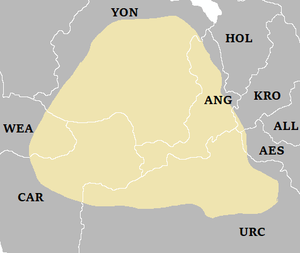Greater Levantine Formation
The Greater Levantine Formation is a distinctive sequence of Late Jurassic and Early Cretaceous sedimentary rock found in central Levantia which has been the most fertile source of dinosaur fossils in Levantia. It is composed of mudstone, sandstone, siltstone, and limestone and is light gray, greenish gray, or red and occasionally under a cover of gneiss and granite. Most of the fossils occur in the green siltstone beds and lower sandstones, relics of the rivers and floodplains of the Jurassic period. The Greater Levantine Formation covers roughly 839,245 sqare miles or 2,173,635 square kilometers although only a tiny fraction is exposed and accessible to geologists and paleontologists. The Greater Levantine Formation is present in Aescaracta, Anglei, Carna, Kronenia, Urcea, Wealdland and Yonderre.

According to radiometric dating, the Greater Levantine Formation dates from 150.2 ± 2 million years old (Ma) at its base, to 138.8 ± 1 million years old at the top, which places it in the Late Jurassic and Early Cretaceous stages of world history. The Levantine Basin, which stretched from central Urcea in the south to Vandarcôte, Yonderre, in the north, was formed during the ideogneiss orogeny, a precursor event to later orogenic episodes that created the Ionian Mountains. The deposits from their east-facing drainage basins, carried by streams and rivers from the present-day Ionian Highlands (along the borders of present-day Urcea and Anglei) and deposited in swampy lowlands, lakes, river channels and floodplains, became the Greater Levantine Formation.
Fossil content
Though many of the Greater Levantine Formation fossils are fragmentary, they are sufficient to provide a good picture of the flora and fauna in the Levantine Basin during the Late Jurassic period. Overall, the climate was dry, similar to a savanna but, since there were no angiosperms (grasses, flowers, and some trees), the flora was quite different. Conifers, the dominant plants of the time, were to be found with ginkgos, cycads, tree ferns, and horsetail rushes. Much of the fossilized vegetation was riparian, living along the river flood plains. Along the rivers, there were fish, frogs, salamanders, lizards, crocodiles, turtles, pterosaurs, crayfish, clams, and mammaliforms.
The dinosaurs were most likely riparian as well. Hundreds of dinosaur fossils have been discovered, such as Joanusaurus, Vollardisaurus, Macrilaimos, Ionitops, several stegosaurs comprising at least two species of Stegosaurus and the early testudosaurs, Aescaractapelta and Conchobarsaurus, most notably a very broad range of sauropods (the giants of the Mesozoic era). Since at least some of these species are known to have nested in the area (Joanusaurus embryoes have been discovered), there are indications that it was a good environment for dinosaurs and not just home to migratory, seasonal populations. However, the large body mass of the sauropods has been interpreted as an adaptation to migration in times of drought.
Sites
Locations where significant Greater Levantine Formation fossil discoveries have been made include:
Anglei
- Dungville Basin: First excavated in 1924 with the purpose of finding sauropods from the Greater Levantine Formation for public display. Several specimens of Macrilaimos as well as partial specimens of Joanusaurus have been excavated in the Dungville Basin.
Carna
- Great Lime Quarry: First excavated by geologists from the University of Dunaird in the late 1920s. Jour & Leon led an expedition in 1931 which discovered that, during the Jurassic, the quarry was a mudhole where several enormous sauropods got stuck and apparently caused a feeding frenzy that lured and trapped many carnivorous dinosaurs. Most specimens of the Joanusaurus subspecies J. carnae are from this site, as well as the unique Dunairdsaurus and Ligmaceratops.
Urcea
- Ardriville: Numerous specimens of mammals, lizards, and crocodiles were found. Most recently the new dinosaur Ardrivilletadens was described from the area.
- Marsbury Quarry: Site of discovery of Big Yon in 1980, a nearly complete Joanusaurus. Subsequent digs have uncovered more fossilized remains, notably a specimen of Stegosaurus stenops was discovered in 1992 with its armor still in place, which confirmed that the dinosaur had two rows of plates on its back.
Yonderre
- Pas-en-Fair Quarry: A former sandstone quarry in Donne from which three partial Joanusaurus specimens have been recovered as well as numerous crocodillians, mammals and fossilized plant matter.
- Vollardic Mountains: Since they were first excavated in the 1860s the numerous quarries and mines in Vollardie have yielded great numbers of fossilized dinosaurs including the eponymous Vollardisaurus, Joanusaurus, Macrilaimos, Aescaractapelta and more.